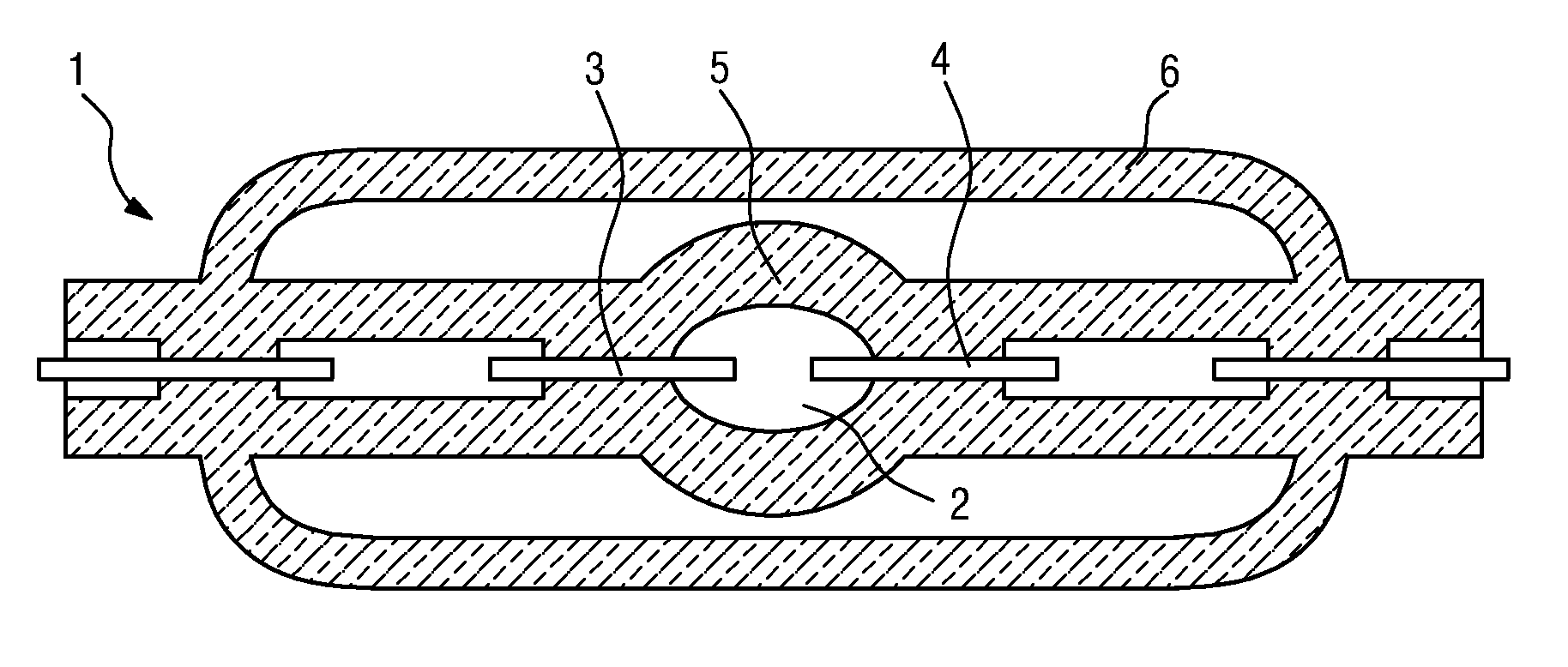[0010]Experiments with the lamp according to the invention, which does not include zinc in the fill
gas composition, have—surprisingly—shown that the absence of zinc does not have a noticeable effect on the lamp
voltage. At the same time, a significantly higher light output can be achieved with at least 30 wt % combined
sodium iodide and
scandium iodide in the fill gas. Therefore, by omitting
zinc iodide and compiling the fill gas to include this minimum combined amount of
sodium iodide and scandium iodide, the lamp according to the invention allows a higher light output to be achieved, without the lamp
voltage being adversely affected in any way. In a simple and economic solution, therefore, the lamp according to the invention provides a particularly high light output while being more cost-effective to manufacture than prior art lamps.
[0011]Another obvious
advantage of the lamp according to the invention is that, with the fill gas described, a
very high level of light output (lumen) per
Watt, i.e. a high level of efficiency, can be reached with a colour temperature well placed in the blue-white region required for automotive applications. The addition of
thulium iodide (TmI3) results in a significant increase in the colour temperature that can be reached at this high level of lamp efficiency. In particular, even for a lamp with a lower nominal power, e.g. 25 W, a favourable colour temperature close to the black-body line can be achieved having the same colour impression as a D4 lamp.
[0012]Advantageously, the lamp according to the invention can be used in place of a prior art D1-D4
headlamp without having to replace any existing
electronics or fittings, so that the
customer requirements mentioned in the introduction can be met.
[0014]Even a small amount of at least 5 wt % of
thulium iodide in the salt fill of the lamp can ensure a satisfactory colour point for the lamp. However, to obtain a lamp with a more blueish colour, preferably at least 15 wt %, more preferably at least 20 wt % thulium iodide is included in the lamp filling.
[0016]As mentioned above, it is highly desirable in automotive applications for the colour temperature of a headlight to lie close to the black-body line in an SAE representation, as will be known to a person skilled in the art. Therefore, in a particularly preferred embodiment of the invention, the
halide composition of the lamp also comprises
indium iodide (InI) to a proportion of at least 0.1 wt % and at most 40 wt %. The addition of
indium iodide serves to lower the Y-coordinate of the colour point. By appropriate choice of the proportions of the
metal salts in the fill gas, a colour temperature can be obtained whose colour point has X and Y-coordinates that lie on, or at least very close to, the black-body line.
[0017]The combined amount of
sodium iodide and scandium iodide in the fill gas, as already indicated, serves to yield a high efficiency of the lamp. Evidently, the relative proportions of these
metal salts can be adjusted as required. With approximately equal levels of
sodium iodide and scandium iodide, i.e. 50:50, the lumen output of the lamp is only subject to minor alteration, while allowing the x-coordinate of the colour point to be positioned closer to the black-body line. On the other hand, increasing the relative proportion of sodium iodide while decreasing that of scandium iodide serves to prolong the lifetime maintenance of the lamp, i.e. the lamp can provide relatively constant lumen output over a longer lifetime. Therefore, in a further preferred embodiment of the invention, the proportion of sodium iodide in the halide composition is at least 15 wt % and at most 60 wt %, and the proportion of scandium iodide in the halide composition is at least 10 wt % and at most 40 wt %.
 Login to View More
Login to View More  Login to View More
Login to View More 


